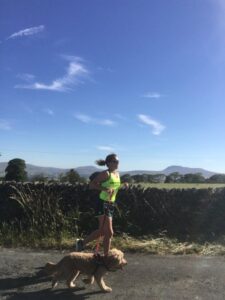Hot flushes, hot flashes, hot sweats, whatever you call them, they aren’t pleasant. Around 8 in 10 women get hot flushes at some point during the menopause transition. If you’re getting hot and sweaty multiple times a day, the idea of voluntarily getting hot and sweaty by going for a run isn’t very appealing! What effect can hot flushes have on your running? Can running reduce hot flushes? There is some good news but there are also some things that runners with hot flushes need to bear in mind.
Why do you get hot flushes?
The hypothalamus is the part of your brain which controls your body temperature. It’s your internal thermostat. The body likes ‘homeostasis’ where everything, including temperature is constant. A nice even body temperature allows all your body processes to run at their optimum level. When the hypothalamus senses core body temperature is rising, it starts a cascade of mechanisms to cool you down. These include:
- Making you sweat – when sweat evaporates off the skin it takes heat with it.
- Flushing of your skin – blood loses heat to the outside when it travels in the superficial blood vessels.
- Increasing your heart rate – to take blood to the skin surface more quickly.
- Increasing your breathing rate – to expel heat and increase oxygen intake as the body is working harder.
It’s a very clever and effective system. During perimenopause however, hormone levels such as oestrogen levels fluctuate, rise and fall. We know there are oestrogen receptors in the brain and changes in oestrogen levels affect brain function. The hypothalamus seems to get more sensitive to changes in body temperature during the perimenopause. It almost ‘over reacts’ or even fires off its cooling mechanisms inappropriately. The amount of blood flow in the brain reduces slightly during a hot flush too. There is so much we don’t understand which is one of the reasons we don’t have treatments that will guarantee to stop hot flushes although HRT does a pretty good job in many women. What we do know is the sensation of heat rising from your feet upwards, the overwhelming feeling of over-heating and the excessive sweating that results, is unpleasant and at times debilitating.
How do hot flushes affect runners?
Having hot flushes can really interrupt your running. You might even have a hot flush while you run which is a really unpleasant sensation! Here are some of the ways hot flushes might affect you as a runner:
- Dehydration – lots of sweating (hot flushes and night sweats included) can mean you’re dehydrated. This can have a knock on effect to your running performance.
- Poor sleep – waking up with night sweats, having to change your pyjamas or even the bed sheets really doesn’t give you a good night’s sleep. Being deprived of sleep makes your running recovery harder and energy levels lower.
- Temperature control – your usual choice of running kit just isn’t working for you. You’re too hot then too cold and can’t get it right, regardless of the weather!
- Low motivation – Getting hot and sweaty when you’re already hot and sweaty isn’t appealing plus you’re tired and getting out of the door is hard.
Can running improve hot flushes?
While hot flushes and night sweats can be a barrier to running, there is some good news! Women who are regularly active tend to suffer less from menopausal symptoms than inactive women. While some studies have shown no improvement or in some cases, a worsening of hot flushes with exercise, there’s growing evidence that exercise itself can reduce the frequency and intensity of hot flushes. This may particularly be the case if you are improving your fitness. When you get fitter, you boost your body’s ability to regulate its temperature and boost brain and skin circulation, making your body more efficient at losing heat. It’s definitely worth keeping going and even stepping up your fitness level to see if it helps. Sudden, intermittent bursts of high impact exercise might make things worse but a regular habit of sustained, longer duration exercise such as running is thought to be most beneficial in terms of managing hot flushes.
How to manage hot flushes and running
It’s impossible to know how long you will be affected by hot flushes. There are some women who only experience a few and for a very short time. There are others who have hot flushes for many years before and after the menopause. It’s a very individual thing. Thankfully there are a few things you can do to help. Here are five tips to help you cope with hot flushes and minimise the impact they have on your running:
- Keep hydrated. If you sweat a lot, you might be a little dehydrated most of the time. Get into the habit of drinking a glass of water when you wake up in the morning. It will counteract fluid lost during night sweats. Drink frequently on and off through the day and especially before and after training.
- Avoid triggers. Certain things such as alcohol, caffeine and spicy foods can trigger hot flushes. Stress can do this too but that can be harder to avoid. It’s worth seeing if there’s any pattern to yours and if there’s anything you can change in your lifestyle.
- Go for layers. Become the master of layering your running kit. You might need to put layers on and off several times during a long run to feel comfortable. It’s possible you have completely changed what you now wear and find yourself in a running vest when you were previously in double thermal base layers! Be flexible and adjust to what feels right for you, ignore what everyone else is wearing.
- Cool your core. You can take steps to keep your core cool which might help stop the cooling mechanisms activating. Choose cooler days, times and shadier routes; it’s often colder at altitude. Windy days can make running harder but might become your favourite as they cool you down more. An iced drink before you run (this is called pre-cooling) can help and consider a small water spray to spritz your face while you run. A hat will keep the sun off your head but if you prefer to have that exposed to help lose heat then try a visor which will just keep it off your face.
- Consider HRT. Whether or not you use HRT is a personal choice and needs a good discussion with your doctor about the pros and cons for your personal situation. But, if it’s suitable for you and you want to take it, it can be an extremely effective way to reduce hot flushes. For some women this is life changing, for others it just makes things a bit more bearable. There are alternatives to HRT too that can reduce flushes such as SSRIs, clonidine and gabapentin. All of these options should be discussed with your doctor. Take care with complementary therapies and supplements. Do your homework about what exactly you are taking. Always buy from a reputable source and if you are on other medications, then discuss your plan with your pharmacist. Head to Menopause Matters for advice and guidance on using alternative therapies.
The menopause is certainly a challenging time. I have two things that might help you…
Sign up for my weekly newsletter for peri and post menopausal runners on the sign up form below. Join my online Run Through the Menopause course if you’re finding the menopause is adding extra challenges to your running. You can find all the info you need here.
Featured image: adrian schüpbach from Pixabay








One Comment